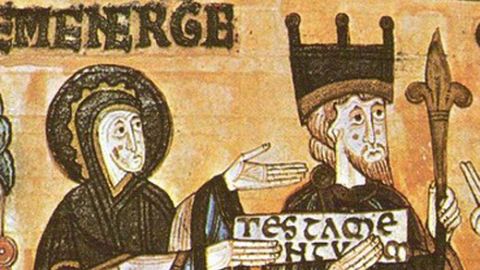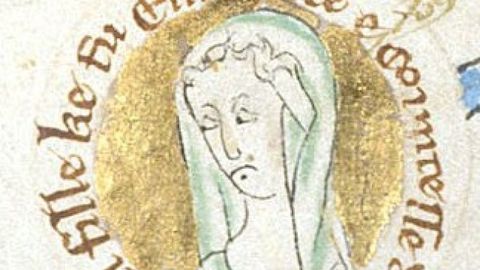
According to the experts, there is no clear answer to this question due to a lack of documentation, as is also the case with the first male pilgrim to Santiago.
30 sep 2022 . Actualizado a las 05:00 h.Jimena of Asturias, Matilda of England, the Infanta Urraca... There are several contenders for the title of first woman to have made the pilgrimage to Santiago. However, the experts agree that, as with male pilgrims, the general lack of documentation from the period makes it all but impossible to identify the first female pilgrim who knelt before the tomb of the apostle. Although women now account for most of the pilgrims according to the official statistics of the Pilgrim’s Office (52% of the compostela certificates of completion were issued to women in the first half of the year), the following question is left hanging in the air, much like the botafumeiro (thurible) during the Day of Santiago Apostle every 25th July: Who was the first woman to walk the Camino de Santiago?
«Finding out who was the first woman to make the pilgrimage to Santiago de Compostela is an exceedingly difficult task, if not outright impossible, because it is one thing to be the first woman pilgrim, quite another to be the first well-known woman to do it, and yet another to figure out what exactly doing the Camino entails,» explains Jaime Nuño González, head of the Centre for Romanesque Studies at the Santa María la Real Foundation and member of the Commission of the Camino de Santiago for Castile and León. «Following the discovery of the tomb of James the Great, there were surely women who made the trip to Santiago de Compostela, although in the early days it would likely have been local women,» he adds.
This is a view shared by María Josefa Sanz Fuentes, professor of Historiographic Sciences and Techniques at the University of Oviedo, who points out that «Female pilgrims would have made the trip to Santiago from the time the tomb was discovered,» but laments that their names will never be known: «The names we do have come from medieval documentation, which is very scarce, and it always talks about queens and other female members of the nobility.»
So what is the first name? According to the publication Las mujeres de la Edad Media y el Camino de Santiago, by Marta Vázquez González, Jimena de Asturias, wife of Alfonso III, might well have been the first female pilgrim to Santiago, as she appears as the companion of her husband on a journey that took place in the year 899. «The sources are dated later ? we know this from copies of documentation ? but they may actually be quite reliable. Pilgrimages as we know them now did not really exist back then, but Jimena is probably the first woman of whom we have actual evidence of having made a pilgrimage of sorts to Compostela,» explains Xosé Sánchez, professor of Medieval History at the UNED in Pontevedra.
The first foreign name appears in 1065: Countess Richardis, wife of Siegfried I, Count of Sponheim in Germany. A little later in the early 12th century, we have Saint Paulina of Fulda and the Infanta Urraca, in 1110. Adeline Rucquoi, member of the International Committee of Experts of the Camino de Santiago, explains that perhaps the best known pilgrim was Matilda, daughter of King Henry I of England: «She was widowed by her husband, the Emperor of Germany, and decided to make a pilgrimage to Santiago in 1125, before returning to England.»

«It’s much the same story for men»
According to the experts, the relative lack of identifiable women is not due to any gender bias. «It’s the same as with the men, as we don’t have a reliable name until 950, when Bishop Godescalco of Le-Puy-en-Velay made the pilgrimage,» explains Nuño González. While tradition would have it that Alfonso II was the first pilgrim, as he ordered the construction of the first basilica after heading there to verify the discovery of the tomb of the apostle, «it does not appear in any documentation,» remarks Xosé Sánchez, professor of Medieval History at the UNED in Pontevedra.
«We now know that the first documented man was an anonymous German man of the cloth, before the famous Gotescalco, bishop of Le-Puy-en-Velay, who went to the sanctuary of Santiago in Compostela midway through the 10th century,» explains Carlos Andrés González Paz, a researcher at the Padre Sarmiento Institute of Galician Studies.
So why is there so little documentation? «We now see the pilgrimage as something worthy of being documented, but back in the day it was a very common occurrence and we can’t find any “mass” documentary evidence until the pilgrims’ hospitals began to take records or until parish registers were kept, which came much later following the Council of Trent», explains María Josefa Sanz Fuentes.
«The documents are largely ecclesiastical and rarely contain such information. We sometimes hear about the travels of prominent figures because they may indeed appear in one or other document from their respective chancelleries. However, the common folk —whether men or women— remain completely anonymous, at least until the 12th century,» adds Nuño González.
The question of status would appear to explain why the first people to have walked the Camino de Santiago, whether men or women, remained anonymous. «The first woman was more than likely a Galician and would have come from the area around Mount Libredón to pay reverence to the recently discovered tomb ascribed to Saint James, although we have no proof of this,» concludes Xosé Sánchez.